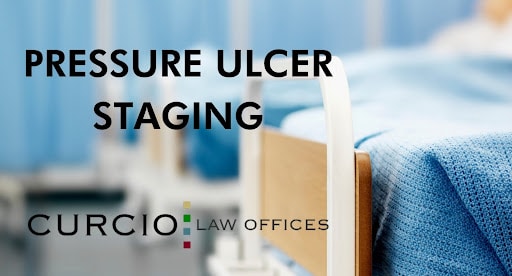Pressure ulcers are painful, debilitating, and affect millions of people every year. You may recognize this condition by another name: bedsores or pressure sores. Medical professionals group pressure injuries in stages, based on the severity of the injuries, that range from mild to life-threatening.
Those who develop these excruciating pressure sores are often the most vulnerable medical patients, such as nursing home residents who are bedridden or have limited mobility. To add insult to injury, pressure sores are avoidable when staff follows proper procedures for resident care. If your loved one developed pressure ulcers while under the short or long-term care of a nursing home or medical facility, the Chicago nursing home neglect and abuse lawyers at Curcio Law will fight for compensation for your loved one’s unnecessary damage.
Our Chicago bed sore lawyers provide immediate legal advice at your free consultation, and all the information you share with us is confidential through our attorney-client relationship.
What is a Pressure Ulcer?
Known as a bedsore or decubitus ulcer, pressure ulcers are lesions formed when continuous pressure cuts off circulation and damages the underlying tissue. As previously mentioned, those most frequently afflicted with the condition are bedridden or immobile, unconscious, or have a loss of sensation. Examples of situations that increase the risk of pressure sore development include sitting in a wheelchair and wearing a cast for an extended period.
Several other factors contribute to the formation of pressure sores. Friction, moisture, shear immobility (a gravity force pressing down on a patient), and medical conditions, such as diabetes, increase the risk of pressure sore development.
The presence of bedsores can speak volumes about the quality of care a person receives.
What Causes Bedsores?
Bedsores develop when pressure on the skin restricts the blood supply for more than a few hours. The skin starts dying as the blood flow dwindles. The affected area is red and painful and turns purple over time. If untreated, a blood filled blister may burst open and become infected.
Bedridden or immobile persons require frequent repositioning, good skin care, and a healthy diet to decrease the chances of developing pressure injuries, as a higher risk of pressure sores exist for those with malnutrition, circulation issues, or diabetes.
Bedsores or pressure sores commonly develop in the following areas of the body:
- Hips or tailbone
- Heels
- Shoulder blades
- Sides and backs of the knees
- Back of the head
- Ankles
Stages of Pressure Ulcers
Physicians stage bedsores according to the seriousness of the wound in relation to the layers of the skin. These injuries range from mild skin reddening to severe tissue damage and infection that affects muscle and bone. Severe ulcers may require surgery or other invasive interventions.
The National Pressure Ulcer Advisory Panel (NPUAP) is an expert group on bedsores. They categorize pressure injuries into four stages. The NPUAP pressure injury stages are:
Stage One Pressure Injury
The skin may be swollen, red, and feel warm due to a prolonged reduction of blood circulation. A stage 1 pressure sore may be painful, but it doesn’t not penetrate below the skin surface.
For those with tan, brown, or black skin, the area may not look red. Instead the patient will exhibit patches of darker skin. Stage 1 bedsores may either feel firmer or softer than the skin that surrounds the pressure injury.
What Does a Stage 1 Pressure Injury Look Like?
The area around stage 1 pressure injuries is red and feels warm. It may have a blue or purple tint on dark-skinned patients. A person with stage 1 pressure sores may experience itching, burning, or pain.
Stage Two
Skin blistering occurs in a stage 2 pressure sore and may have a clear discharge. The ulcer may extend into the second layer of the skin, known as the dermis. Stage 2 pressure ulcers may look like a blister, open sore, abrasion, or shallow crater in the top layer of the skin.
Treating stage two ulcers is critical so they don’t progress into a life-threatening infection. Untreated bedsores may infect the heart, blood, or bones and lead to amputation or death.
Stage Three
Stage three ulcers are deep craters that reach down into the hypodermis or fatty layer of the skin. A stage 3 bedsore will show obvious signs of infection, as the painful area has extended to the deeper layers of the skin.
What Does a Stage 3 Pressure Ulcer Look Like?
A pressure ulcer may be a blister full of clear liquid at stage three. The skin may not respond to treatment at this point, or it may die. The sore forms a small crater in the skin and reaches the tissue beneath it. The fatty layer may be visible.
Stage Four
A stage 4 pressure sore wound extends to the ligaments, tissue, muscle, and sometimes even the bone. Sores that are in stage 4 show painfully obvious signs of infection. These sores are often excruciating, affecting the deeper tissues and ligaments. In severe cases, stage four ulcers may even cause death.
In stages 3 and 4, the patients may not feel pain anymore, as the tissue and nerve endings are often severely damaged. These stages of pressure sore injuries don’t happen overnight, but instead over a prolonged period that the patient remained in one position.
What Does a Stage 4 Bedsore Look Like?
Stage four decubitus ulcers are deep holes, craters, or tunnels in the skin. The skin around the opening may be red or inflamed, and dead tissue may be present. Tendons, muscles, or bones may be visible inside the sore. The sore may ooze pus and emit a foul odor.
A patient developing a stage four pressure ulcer may be a sign of Chicago nursing home neglect or abuse. Stage four sores may develop when nursing home staff fail to treat the sores at an earlier stage.
Other Stages
There are two additional bed sore stages: unstageable and Suspected Deep Tissue Injury.
Unstageable
If the bottom of the sore is not visible, it is considered “unstageable.” Medical staff can’t see the wound bed until they clean it out.
“Suspected Deep Tissue Injury” (SDTI)
An SDTI occurs when pressure sores look similar to sores that have only progressed to a stage 1 or 2 on the surface but in actuality, these sores have progressed to a 2 or 4 beneath the skin’s surface.
Proper care prevents pressure ulcers. If a sore does form, regardless of what stage it has progressed to, immediate treatment is critical so it does not worsen. Depending on the sore’s severity, treatment may include pressure relief devices, special wound dressings, and antibiotics for infection.
Risk of Bedsores
The risk of bedsores increases if:
- Nursing homes or medical facilities are understaffed and therefore cannot provide adequate care for residents.
- Staff allows residents to become malnourished or dehydrated which prevents healing of existing sores.
- Caregivers rush their care and fail to notice or treat earlier-stage sores.
- Staff don’t reposition mobility-impaired residents to relieve pressure on their skin.
What are the Complications of Bedsores?

Those who are bedridden are at high risk of developing bedsores. Stage one or two bedsores are common in those with limited mobility and become life-threatening if left untreated.
Amyloidosis- Organs cannot function properly due to protein building up in the body. This condition is incurable.
Infection- An ulcer may become infected after it breaks open.
Osteomyelitis- The ulcer area swells, and the bone hurts when touched. Loss of bone may occur.
Sepsis and Septic Shock- Sepsis may occur when the immune system overreacts and attacks healthy body parts during severe infection. In more severe cases, the blood pressure drops, causing septic shock. This condition may be deadly if major organs shut down. (We answer ‘”What are the 3 stages of sepsis?”, in the highlighted blog)
Death- Many of the above conditions may become fatal if they or the bedsores remain untreated. Amyloidosis is among the most common causes of death for those with chronic pressure sores. Stage 4 bedsore life expectancy isn’t good.
Families may file a Chicago wrongful death claim if a nursing home patient dies from untreated bedsores.
Medical Malpractice in Nursing Homes
When a patient suffers harm because a medical professional fails to provide an appropriate standard of care, this could potentially lead to a Chicago medical malpractice claim. This type of professional negligence may include incorrectly handling a medical procedure, failing to diagnose a condition, not monitoring a patient’s condition, or prescribing incorrect medication.
The Chicago nursing home infections lawyers at Curcio Law have extensive experience with nursing home abuse cases and know how to prove medical malpractice.
Treating Pressure Sores
Treatment for bedsores depends on the severity of the condition and your wound care team’s recommendations. Pressure sores are harder to care for after the skin breaks. Treatment may include:
- Reducing or removing pressure from the area
- Applying protective medicated dressings
- Keeping the wound clean and dry
- Making sure the patient eats nutritious meals
- Debriding (removing) dead, damaged, or infected tissue in and around the sore
- Grafting healthy skin to the wound area
- Negative pressure wound therapy
- Prescriptions for pain or infection
Medical staff should monitor the pressure sore and track the wound’s depth, size, and response to treatment.
Are Bedsores Preventable?
Yes, bedsores are absolutely preventable. There are several methods for preventing bedsores. The first is checking the skin for signs of redness each day and paying attention to bony parts of the body. Additional ways of preventing bedsores include:
- Repositioning immobile patients every two hours
- Ensuring those in wheelchairs sit up straight and change position frequently
- Reducing pressure in wheelchairs and beds with soft padding or foam wedges
- Keeping skin clean and dry
- Proper nutrition and hydration. A patient needs fluids, minerals, vitamins, protein, and enough calories to promote healing.
Chicago Bedsore Injury Law Firm
You must take immediate action if your loved one develops bedsores. You will prevent their condition worsening and ensure other facility residents don’t suffer neglect as well.
An experienced Chicago nursing home abuse attorney helps prove the liable party exercised negligence in their duty of care to their patient. Proving negligence can be tricky, but the legal team at Curcio Law is familiar with Illinois elder abuse laws. Our super lawyers work tirelessly to get you the compensation you or your loved one deserve for pain and suffering, medical expenses, and other damages.
The nursing home abuse lawyers at Curcio Law work for you on a contingency fee basis. We get paid when you get your award. Illinois has a two-year statute of limitations for personal injury or wrongful death claims. So please don’t wait to reach out to us. We are here to help you through this difficult time. You may reach us at (312) 321-1111.
In addition to Chicago elder abuse, our firm handles various aspects of the law, including Chicago pedestrian accidents, Chicago cancer misdiagnosis, Chicago commercial vehicle accidents, and more.



